On Corfu, one of Greece's Ionian Islands, residents enjoy wild greens cooked with hot peppers. The spicy greens are called Tsigareli and are served hot (in Greece, many dishes using wild greens are served at room temperature). The dish is so beloved that Corfiot restaurants attract customers by bragging about their Tsigareli.
Located off the southwestern coast of Albania, Corfu was for many years a Venetian colony, and a stop on Venetian trade routes from the Middle East. That heritage is reflected in Corfu’s traditional dishes, including Tsigareli.
Most peasant dishes are made without formal recipes. As a result, a single, correct way to make them doesn't exist. So it is with Tsigareli, whose name comes from the Greek verb “tsigarizo” (τσιγαρίζω) meaning to sauté or brown. Today in Corfu, Tsigareli is usually made with a selection of blanched wild greens and spicy tomato sauce. Traditionally, tomatoes were not used, and the dish got its color from dried red peppers. Some recipes for Tsigareli include ground meat, some ignore tomato sauce and use potatoes and cayenne pepper for flavor, and still others sweeten the tomato sauce with carrots.
Today in Corfu, Tsigareli is usually made with a selection of blanched wild greens and spicy tomato sauce. Traditionally, tomatoes were not used, and the dish got its color from dried red peppers. Some recipes for Tsigareli include ground meat, some ignore tomato sauce and use potatoes and cayenne pepper for flavor, and still others sweeten the tomato sauce with carrots.
Aglaia Kremezi, a respected Greek cookbook author, suggests adding rice to Tsigareli, or serving it over Polenta with Currents and Onions. Either would make a hearty main course. Another well-known Greek writer, Diane Kochilas, suggests flavoring it with fennel bulb and fennel seeds.
In all recipes, the major components of Tsigareli are mixed greens, hot spices, and abundant herbs. These ingredients can be adjusted with the seasons, or to suit personal tastes. The dish can be served as an appetizer, a side dish, or an entree. Tsigareli is best made with wild greens, but when they aren’t available, it is delicious made with supermarket greens.
For a tasty vegan main course, follow Aglaia Kremezi’s recommendation and serve Tsigareli with a starch like rice or polenta. To accompany fish, make it with less tomato sauce and sweeter greens. Lamb is complemented by strong-flavored greens in a rich, hearty tomato sauce.
Leaf (Chinese) celery enhances Tsigareli, and I add it in two stages to better accentuate its flavor. Ordinary supermarket celery is fine for this dish, although it has a milder taste than leaf celery. For more information about leaf celery, go here.
Aleppo pepper is a fruity and moderately spicy red chili pepper sold in crushed flakes. It originally came from Syria, but now may be imported into the United States from Turkey. Supermarket crushed red pepper is a spicier and less flavorful substitute for Aleppo pepper; one-half teaspoon of crushed red pepper substitutes for one teaspoon Aleppo pepper. Aleppo pepper is available from Penzey’s, The Spice House, and World Spice Merchants.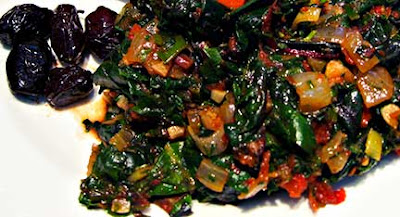 Wild Greens with Celery-Mint Tomato Sauce (Tsigareli / Τσιγαρέλι)
Wild Greens with Celery-Mint Tomato Sauce (Tsigareli / Τσιγαρέλι)
Serves 4 - 6
Tsigareli tastes best when made with a mixture of different kinds of greens. Use the larger amounts of Aleppo or crushed red pepper only if you enjoy spicy food. The tomato sauce used in this recipe is excellent when
Greens:
4 bunches of various greens (kale, spinach, Swiss chard, escarole, mixed wild greens) to equal 4 cups of blanched, chopped greens
Salt
Freshly ground black pepper
Tomato Sauce:
4 cups diced onions, 1/4” dice
3/4 cup finely sliced stalks from leaf celery (or 3/4 cups diced celery, 1/4” dice)
1/3 cup olive oil
Salt
Freshly ground black pepper
1 – 2 tsp. Aleppo pepper or 1/2 – 1 tsp. crushed red pepper
2 Tbsp. minced garlic
1 14.5-ounce can crushed tomatoes
3/4 cup dry white wine
1 cup water
3/4 cup finely shredded leaves from leaf celery (or 3/4 cup minced parsley)
3 Tbsp. minced mint
Prepare the Greens: Wash the greens and remove any damaged portions. If using greens with sturdy but edible stems, like beet greens or chard, cut off the stems and chop them into bite-sized pieces. Tough stems, like those on kale, should be discarded.
Blanch the stems and greens in boiling, salted water, adding the stems first, then sturdy greens like beets or kale, and finally tender greens like spinach or escarole. As soon as the tender greens wilt, pour the greens into a colander to drain and cool. Roughly chop the greens when they are cool enough to handle.
Make the Tomato Sauce: Sauté the onions and celery stalks in olive oil, lightly seasoned with salt and freshly ground black pepper, until the onion starts to turn golden. Stir in the Aleppo pepper and garlic and cook for one minute. Stir in the crushed tomatoes, wine, and water and bring to a boil. Cook rapidly for five minutes, stirring constantly. Turn down the heat to medium, stir in the celery leaves (or parsley) and mint, and simmer for 15 minutes.
Finish the Tsigareli: Add the drained, chopped greens to the tomato sauce, and simmer for 10 - 15 minutes or until the sauce is the thickness you desire and no longer watery. Taste and add salt and freshly ground black pepper, if needed.
Serve with crusty bread and Kalamata olives.
~~~~~~~~~~~~~~~~~~~~~~~~~~~~~~~~~~
This is my entry for Vegan Ventures organized by Tasty Palettes.

 When people hear we live in Alaska, they want to know how we survive the cold. For me, the cold is a minor inconvenience; short winter days and too much darkness take more of a toll.
When people hear we live in Alaska, they want to know how we survive the cold. For me, the cold is a minor inconvenience; short winter days and too much darkness take more of a toll. Baked White Beans with Tuna and Sage
Baked White Beans with Tuna and Sage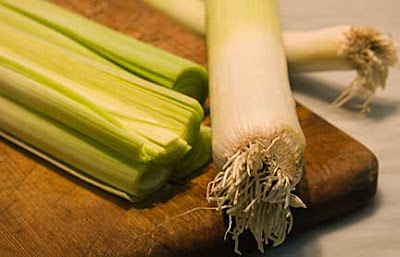 Between
Between 
 To round out the meal, I made Leek Pilaf (Πρασόρυζο), an easy and flavorful Greek dish enjoyed during the many
To round out the meal, I made Leek Pilaf (Πρασόρυζο), an easy and flavorful Greek dish enjoyed during the many  Winter Squash with Onions (Κολοκύθι Κόκκινο με Κρεμμύδι)
Winter Squash with Onions (Κολοκύθι Κόκκινο με Κρεμμύδι)

 The recipe for Greek Village Bread is in
The recipe for Greek Village Bread is in 
 My mother-in-law packed four of the surprisingly large, tree-ripened lemons and shipped them to Alaska. Meyer lemons I’ve seen in the past have been smaller than regular lemons; these were so large I doubted their pedigree. The largest of the lemons weighed one half pound.
My mother-in-law packed four of the surprisingly large, tree-ripened lemons and shipped them to Alaska. Meyer lemons I’ve seen in the past have been smaller than regular lemons; these were so large I doubted their pedigree. The largest of the lemons weighed one half pound. Rosemary and Garlic Roasted Sweet Potatoes
Rosemary and Garlic Roasted Sweet Potatoes
 Chicken and Toursi (Κοτόπουλο με Τουρσί)
Chicken and Toursi (Κοτόπουλο με Τουρσί) Working Together: Froso and Kyria Fani Shaping Traxanas
Working Together: Froso and Kyria Fani Shaping Traxanas Froso and Kyria Fani had begun making hilopites an hour earlier. The women had already mixed and kneaded the dough. Froso was deftly “opening” the dough (opening is the word Greeks use instead of “rolling out”). Her hands moved with skill and speed over the dowel she used as a roller.
Froso and Kyria Fani had begun making hilopites an hour earlier. The women had already mixed and kneaded the dough. Froso was deftly “opening” the dough (opening is the word Greeks use instead of “rolling out”). Her hands moved with skill and speed over the dowel she used as a roller.


 Kyria Fani and Froso rapidly rubbed the dough back and forth across the koskino’s screen, breaking the chunks into tiny pieces of pasta. Like the hilopites, the trahanas was laid out on a sheet-covered bed to dry.
Kyria Fani and Froso rapidly rubbed the dough back and forth across the koskino’s screen, breaking the chunks into tiny pieces of pasta. Like the hilopites, the trahanas was laid out on a sheet-covered bed to dry. Hilopites (Χιλοπίτες)
Hilopites (Χιλοπίτες)

 Recipe: Pan-Fried Scallops with Caramelized Onions and Spinach (Χτένια με Σπανάκι Σύβραση)
Recipe: Pan-Fried Scallops with Caramelized Onions and Spinach (Χτένια με Σπανάκι Σύβραση)

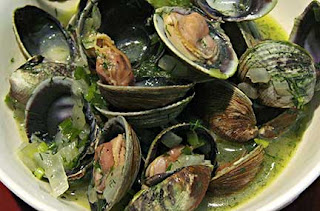
 Traveling provides opportunities to encounter new foods, new ingredients, and new preparations. I’m always on the lookout for eateries run by talented chefs. I’m thrilled when I find a dish I’ve never heard of before, and order it immediately, just to discover what I’ve been missing.
Traveling provides opportunities to encounter new foods, new ingredients, and new preparations. I’m always on the lookout for eateries run by talented chefs. I’m thrilled when I find a dish I’ve never heard of before, and order it immediately, just to discover what I’ve been missing. --Fava Pantremeni (pureed yellow split peas with capers, tomatoes, and onions)
--Fava Pantremeni (pureed yellow split peas with capers, tomatoes, and onions) Beet-Yogurt Spread (Σαλάτα με Παντζάρια και Γιαούρτι)
Beet-Yogurt Spread (Σαλάτα με Παντζάρια και Γιαούρτι)



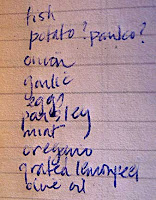

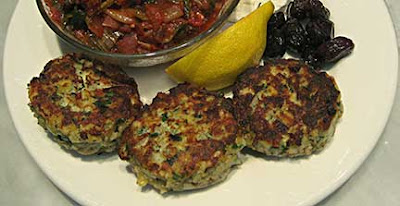


 One of the challenges celery root presents for the cook is that it is not uniformly shaped, and can look like a misshapen ball of tangled roots. Many people avoid buying celery root because they are not sure how to reach the edible portion of the vegetable. If you are one of those people, don’t worry, prepping celery root is easy.
One of the challenges celery root presents for the cook is that it is not uniformly shaped, and can look like a misshapen ball of tangled roots. Many people avoid buying celery root because they are not sure how to reach the edible portion of the vegetable. If you are one of those people, don’t worry, prepping celery root is easy.




